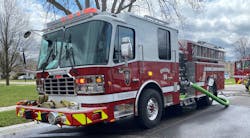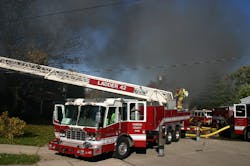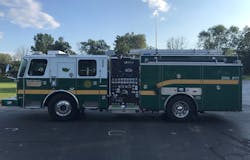Often, the only metric that’s considered by an apparatus purchasing committee in determining whether a single-role or combination fire apparatus is needed is the availability of staffing. Although significant, several other items must be taken into account to ensure that you purchase the correct apparatus for your response area.
Beyond staffing
Fire department staffing varies greatly across the country. Staffing can comprise volunteers, paid on-call, part-time and/or career. You must be realistic with current staffing and deployment models, because most staffing numbers likely never will increase over what they are today. Many major urban centers successfully run combination apparatus, while many suburban organizations successfully run single-role apparatus.
Additional metrics that are utilized in the specification of single-role versus combination fire apparatus are regional geography, previous incident data and department capabilities.
Regional geography
Regional geography begins with the community’s setting, such as urban, suburban and rural. The metric also includes population density, development densities and station distribution.
Urban departments typically are afforded the luxury of specifying task-specific apparatus. This includes traditional engines and trucks and special service apparatus. Because of increased population and development densities, closer fire station distribution generally plays a role in regional geography, too. In other words, the appropriate aid (apparatus) generally isn’t that far away.
The regional geography of suburban departments can vary greatly, and in many metropolitan regions, the line for the suburban/urban interface is becoming blurred, because the major metropolitan centers are running out of available land for development.
Often, the infrastructure of the suburban region, including fire station density and fire company staffing levels, lags behind development. This “maturity” of the region can dictate how fire apparatus is designed. More mature regions often are capable of utilizing single-role apparatus, whereas newer regions can tend to rely on combination apparatus.
Rural fire departments arguably have the most difficult time ensuring adequate daily staffing levels. They also lack the substantial population density and development densities to support 24-hour on-station staffing. To this point, it normally isn’t feasible for rural departments to purchase single-role apparatus. Rescue-engines (squads) and engine-tenders are becoming the norm in many of these communities because of the daily fluctuation of staffing and the increased distance that’s at play in the distribution of fire stations. Often, only a single unit might be available to respond during normal work hours.
Population density
Population density is the concentration of individuals in a defined geographical area. This figure can be measured by the square mile or, for smaller developments, by the square acre.
A community’s current and projected population densities have a direct correlation to a company’s call volume. The population’s density can either increase, decrease or remain relatively static. Gathering this information for the apparatus that the members of the apparatus purchasing committee are specifying is essential. Most municipal zoning departments can generate real-time information relatively quickly.
Conversely, development density is measured by the number of dwelling units that are in a defined geographical area, again measured by the square mile or square acre.
In the context of planning, municipalities often set density limits to control the intensity of a development, such as its height, bulk and setbacks. The fire department should know these density limits and ensure that its response apparatus have the capability to protect all occupancy types in a response area.
Station distribution
Having a grasp on station distribution allows you to know what resources are available and where any gaps and/or overlaps in coverage and by service type exist. Utilizing NFPA 1710: Standard for the Organization and Deployment of Fire Suppression Operations, Emergency Medical Operations, and Special Operations to the Public by Career Fire Departments and NFPA 1720: Standard for the Organization and Deployment of Fire Suppression Operations, Emergency Medical Operations, and Special Operations to the Public by Volunteer Fire Departments aids the apparatus purchasing committee greatly regarding station distribution.
Given that we all should be operating under seamless boarders at this point no matter our regional geography, neighboring communities’ stations and apparatus should be taken into account by the apparatus purchasing committee. An unbiased look at mutual-aid response times to specific target hazards and developments within your community, including the closest, most appropriate companies to an incident scene, must be analyzed.
The correlations to specification from a community’s regional geography, associated densities and station distributions are many. The farther that your response district is from an urban center the more that the likelihood of purchasing combination apparatus increases. This is significant, too, when determining water tank sizes for pumping apparatus.
Population densities have a direct correlation to call volumes for both fire and EMS responses as well as infrastructure congestion. Development densities correlate to the size of the apparatus, wheelbase, turning radius, hoseline and portable ladder packages as well as aerial length, types and outrigger configurations.
Incident data
The four main areas that should be considered for data from previous incidents for both response zones/districts and individual fire companies are: quantity of annual responses; types of responses; actions that are taken at these responses; and average annual miles and hours per company.
Of course, the types of responses vary greatly among individual response zones/districts and fire companies, so these data must be extracted and analyzed. Response out of multiple fire stations has a direct correlation to population and development densities. This is particularly true when an organization provides EMS to its community. As well, the consultation can change drastically by a zone/district’s occupancy types.
Department capabilities
Actions that are taken by fire companies at emergency incidents is another data point that must be considered.
It’s important to ensure that company officers enter these data into the National Fire Incident Reporting System (NFIRS) accurately. To me, this is the way by which a department truly shows its worth as critical infrastructure in its community. Listing most actions that are taken as “investigation” makes it difficult for the administration to justify expenditures.
Data that derive from tracking the annual mileage and hours that are placed on fire companies greatly aid in the justification of increasing, decreasing or relocating a fire station and/or fire company. These same statistics also play a significant role in apparatus replacement and procurement cycles.
Placing complicated combination apparatus in busy fire stations has the propensity to drastically increase the vehicles’ out-of-service time. Therefore, ensuring that you track and benchmark all of your apparatus’ in-service time (uptime in fleet management) is imperative. There is a direct correlation between the complexity of an apparatus specification and the apparatus’ annual in-service time throughout the vehicle’s life cycle. In addition, this aids the members of the apparatus purchasing committee in their decision-making process.
The correlation to specification of previous incident data also is significant. Response quantity and type give you clear insight to the current and future needs of your apparatus. The actions that are taken by individual fire companies provides invaluable information about the specific duties that regularly are performed by fire companies. We have seen single-duty apparatus replaced by combination apparatus and vice versa.
Tracking fleet annual miles and hours over the life of apparatus provides accurate information on annual usage. Generally speaking, the busier that a company is the less complicated that the specification becomes. Again, there’s a direct correlation between the complexity of a specification and a unit’s out-of-service time.
Department services
Fire department services vary greatly across the United States and Canada: fire suppression, rapid intervention, EMS, wildland, vehicle extrication, technical rescue disciplines and hazmat mitigation, to name just a few.
Each service that’s provided by a department (refer to your previous incident data) requires a very specific equipment package to ensure efficient and effective operations at the task level. The equipment package doesn’t change if your apparatus-needs analysis steers you toward some type of combination apparatus. The equipment must meet the specified duties of the apparatus, because the equipment that’s carried on the apparatus often is more important than the apparatus itself.
Defining an equipment package is fairly straight forward if you are specifying single-duty apparatus for any of the aforementioned disciplines. When specifying combination apparatus, early decisions must be made on which disciplines are to be covered by the apparatus.
No one apparatus type can carry all of the equipment that’s required to mitigate each hazard that’s encountered in the public-safety arena. In other words, a department only has a finite amount of storage capacity and weight around which to develop your equipment package.
It isn’t uncommon to see the size and weight of an apparatus get away from the apparatus purchasing committee when it attempts to cover as many disciplines as possible with combination apparatus.
I’m a huge proponent of the division of labor on the fireground. However, we know that isn’t always possible, and personnel and apparatus must wear many hats. This undoubtedly complicates things. Ensuring that you carry the needed equipment to efficiently and effectively complete the duties of the apparatus at the task level is essential. The last thing that you want as an administrator is for personnel to have to compromise the safety of an operation because you attempted to specify “all-in-one” apparatus—which isn’t possible.
Qualitative and quantitative
The goal of the apparatus purchasing committee is to ensure that apparatus will have a long, usable life. This not only increases the efficiency and effectiveness of personnel but their safety as well.
Specifying an apparatus is both qualitative and quantitative, and a department likely will have specific metrics that are required to aid in the decision-making process that aren’t noted above. The process shouldn’t be taken lightly.
About the Author

Mark Miller
Mark Miller is a 26-year veteran of the fire service and currently is a deputy fire chief in Southwest Ohio. He holds a master’s degree in public safety administration, the Executive Fire Officer designation from the National Fire Academy and the Chief Fire Officer designation through the Center for Public Safety Excellence. Miller routinely speaks on fire apparatus positioning on the fireground and conducting an apparatus needs analysis.


